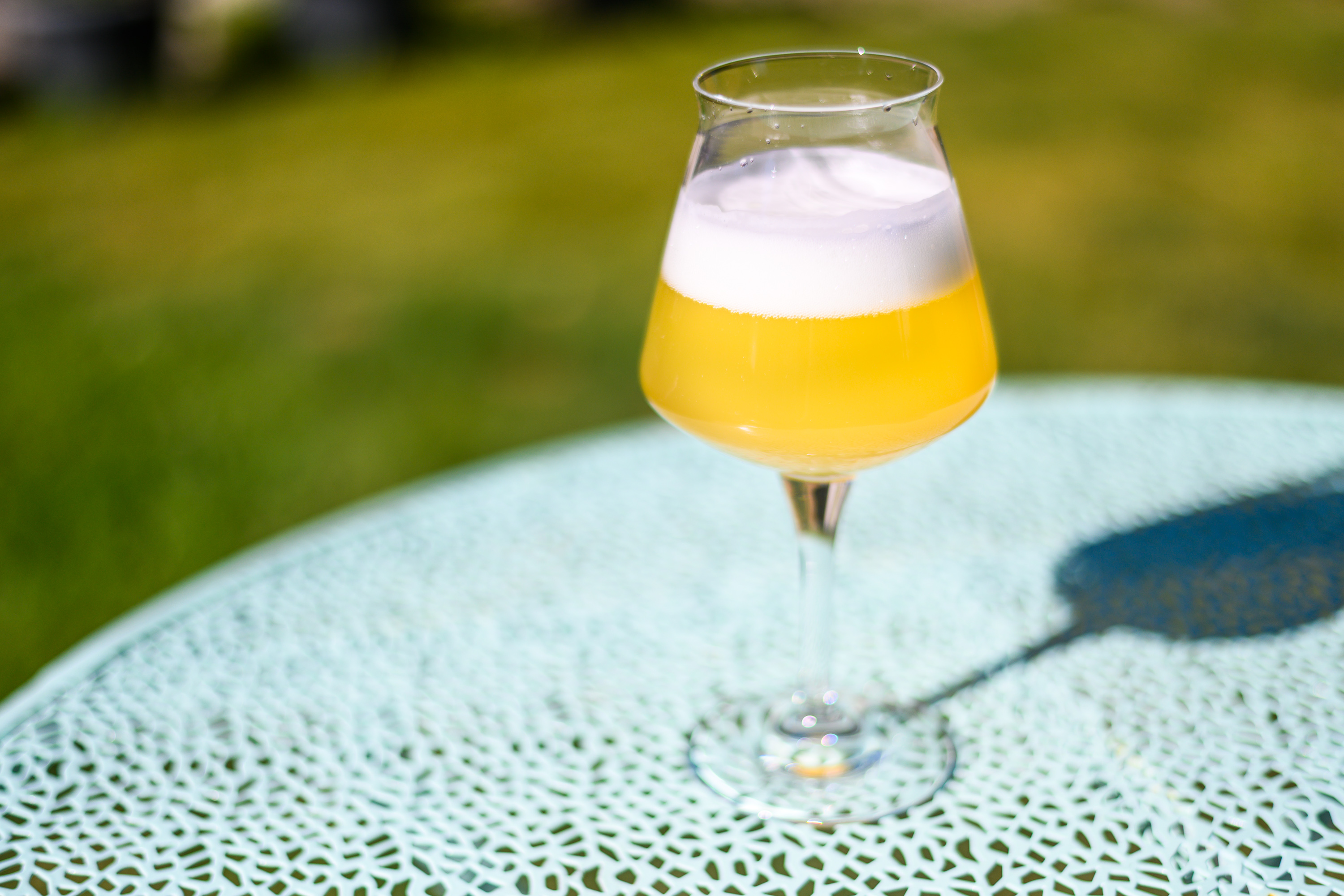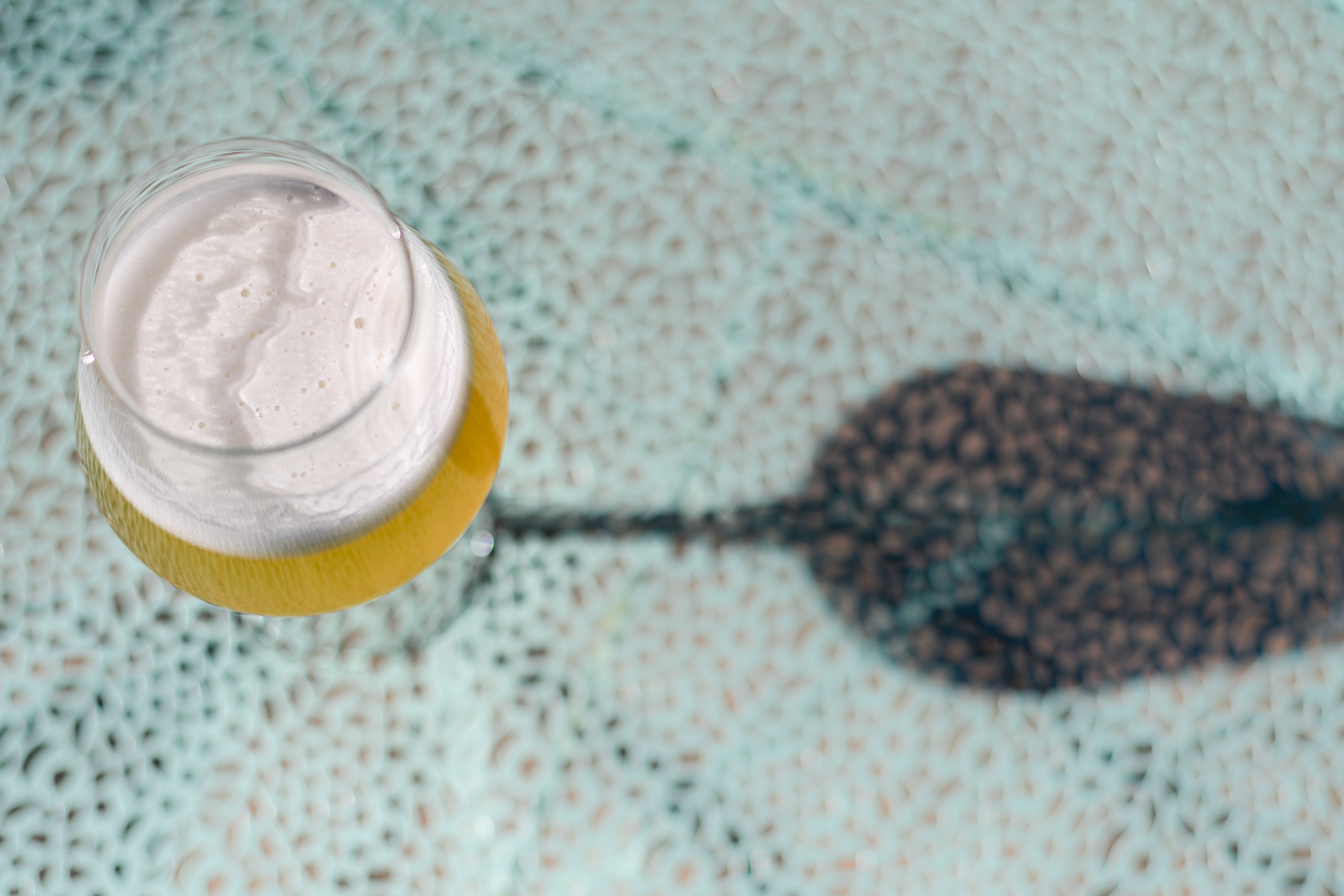More lemony than lemons.

Around Memorial Day this year Allison and I headed south—a grueling 13-hour straight shot in the car to visit her parents down in LA. The drive sucked, but LA is wonderful… to visit, anyway. And one of the best things about visiting LA is foraging in Allison’s mom’s huge garden. California being California, her garden is producing year-round, and she grows some really cool stuff.

This trip, I transplanted a lemon thyme bush, harvested some finger limes that are destined for a soon-to-be-brewed gose, and brought up the two Centennial hop plants I planted last year.
I also grabbed two other things that I recently used in a fun, funky, last-minute sort of beer: a few Meyer lemons and a whole bunch of lemon verbena.
If you’re familiar with lemon verbena, it’s probably from its use in various cosmetic products. It’s a really tasty herb, though—one I’ve heard described as “more lemony than lemons.” After tasting some of Allison’s mom’s verbena, I knew I had to use it in a beer.
I decided it would be a Belgian pale ale of sorts, and I chose Cashmere hops to further accentuate the lemon character. To dry it out, I co-pitched Belgian yeast with half a packet of saison yeast—both from the mad lads at Crossmyloof Brew in Scotland. Pro tip: You can pick up 10 packets of their various dry yeasts—pick your own variety pack!—for just over $10 shipped. Helluva deal.
What’s in it?

The Vitals
- Method: BIAB, no sparge, megasqueeze
- Batch size: 5.5 gallons
- Mash: 60 minutes
- Boil: 60 minutes
- OG: 1.054
- FG: 1.007
- ABV: 6.2%
- IBU: 40
The Grain
- 8 lb Mecca Grade Pelton (Pilsner)
- 2 lb Briess Rye Malt
- 1 lb Mecca Grade Shaniko (White Wheat)
The Hops
- 15g Comet [10.5% AA] @ 60 minutes
- 25g Cashmere [7% AA] @ 15 minutes
- 35g Cashmere @ Whirlpool (170F), 20 minutes
- 30g Cashmere @ Dry Hop, 4 days
The Rest
- Yeast: 1 packet Crossmyloof Belgian (sub Wyeast 3522 or any dry Belgian strain) + 0.5 packet Crossmyloof Lille Saison (sub Wyeast 3711 or Belle Saison)
- Water: Machine RO + 6g lactic acid, 5.5g gypsum, 2g calcium chloride, 1.5g Epsom salt, 0.5g table salt
- Extras: 0.5oz fresh lemon verbena leaves + zest of two Meyer lemons (at FO)
How’d it go?

The more I brew, the fewer issues I run into. At the same time, the less I care about hitting my numbers exactly. I think mash pH is pretty important, water chemistry makes a big difference in the end product, choosing the right ratio of malts is key, and starters are crucial for fast, clean fermentations with liquid yeast (if that’s what you’re after).
But hitting 1.060 or whatever, right on the money? I don’t really care. (Unless I’m brewing for a competition where BJCP rules matter, anyway.)
This batch, my numbers came out a bit wonky. According to BeerSmith, my target OG was 1.055. According to Priceless BIAB Calculator (which usually comes in a bit higher with its estimates, and tends to be closer to my actuals) it was 1.059. What I got was 1.054. Weirder still, my OG was only two points higher than my pre-boil reading. In other words, one of those readings was probably wrong. But eh, who cares if the beer tastes good in the end? It’s not like this one conforms to any particular style, anyway!
Anyway, 60-minute mash at 150F, 60-minute boil. Easy peasy. Since I use BIAB, the two pounds of rye (~18% of the grist) was no issue, but if you make this beer with a traditional three-vessel setup, you’re going to want to use some rice hulls. Though the recipe above says to add the zest and verbena at the same time, at flameout, I actually added the zest a couple minutes before the end of the boil. I don’t think it really made a big difference, though, so I’d just stick with the recipe next time. The verbena I added in a hop bag, and I removed it after the Cashmere whirlpool.
Like usual, I transferred the chilled wort via gravity, letting it freefall from my Robobrew into the SS Brew Bucket below. LoDo adherents, cover your ears, but I think this is the best/easiest way to aerate the hell out of wort before pitching. Anyway, I co-pitched the yeasts at a balmy 72F and let it rip. By the morning it was bubbling away (about 12 hours), and the temp free-rose to 80F during the course of the day. I left it outside overnight to cool a bit in the brisk night air, and by the next morning (roughly 36 hours post-pitch), it was done. FG 1.007, for a lovely 6.2% ABV (assuming my OG reading was correct, anyway).
Since I was headed to NYC the following day for a work trip, I let the beer sit another two weeks before dry-hopping, then kegged without cold-crashing after three days on the dry hops. Like usual, I burst carbed at 40 PSI for 24ish hours before lowering it to serving temp and letting it condition for a week or so.
How’s it taste?

When I first tasted (and smelled) a sample of the finished beer, I thought I’d way, way overshot the verbena. It positively jumped out of the glass and drowned out most of the beer’s other characteristics. After a month in the keg, though, it’s balanced out. Honestly, I think this is one of the most interesting (and successful) beers I’ve made to date.
Appearance: A hazy, bright straw yellow like an unfiltered pils. The head is gorgeous, fluffy and long-lasting, and can be easily roused again once it finally settles. I’m going to attribute that to the extra proteins from the rye. This beer looks like summer.
Aroma: Lemon, first and foremost. Zest and a little pith, but not the kind of lemon Pledge thing you sometimes get in a poorly made lemon beer. Then a slight undercurrent of typical saison and Belgian phenolics: black pepper, other anonymous spices, and a hint of banana.
Taste: Light tartness driven by the lemon zest, then an herbal, slightly vegetal quality that’s presumably from the verbena. The saison flavors come through here as well, giving it a prickly spice character. The hops are restrained, but lend a distinctly fruity overtone and moderate bitterness that lingers on the tongue.
Mouthfeel: Unusually thick and fluffy for a saison, or even a Belgian pale ale (again, probably due to the rye), but it finishes pleasingly dry. The carb is effervescent, which helps balance out the thickness.
Would I brew it again?
Absolutely! I’d like to try it again with a similar yeast profile, but I’d use more assertive hops to make it more of a Belgian pale ale and less of a saison next time. I think lemon verbena has great potential in light, fruity styles, and I kind of want to try it in a gose or Berliner, too.

2 Comments